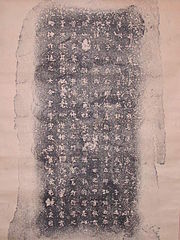Portal:Ancient Japan/Selected lists/2
| This page is currently inactive and is retained for historical reference. Either the page is no longer relevant or consensus on its purpose has become unclear. To revive discussion, seek broader input via a forum such as the village pump. |

The term "National Treasure" has been used in Japan to denote cultural properties since 1897. The definition and the criteria have changed since the inception of the term. The writings in this list of documents designated as National Treasures of Japan contains items of various type such as letters, diaries, records or catalogues, certificates, imperial decrees, testaments and maps. Writing was physically introduced to Japan from China in the form of inscribed artefacts around the year 1 BC. Examples, some of which have been designated as archaeological national treasures, include coins of the reign of Wang Mang (AD 8–25), a 1st century gold seal from Shikanoshima, a late 2nd century iron sword from the Tōdaijiyama burial mound, the Seven-Branched Sword with inscription from 369 and a large number of bronze mirrors—the oldest dating to the 3rd century. All of these artifacts originated on the continent, most likely in China. The concept of writing came to Japan from the Korean kingdom of Baekje in the form of classical Chinese books likely written on paper and in the form of manuscript rolls. The oldest texts of Japanese origin, which show a clear understanding of the concept of writing, date to the 5th century and are inscriptions on stone or metal.
Examples include three archaeological National Treasures: Suda Hachiman Shrine Mirror from about the 5th century, which is a poor copy of a Chinese original, the Inariyama Sword from 471 or 531 and the Eta Funayama burial mound sword from about the 5th century. The abrupt transition from an unfamiliarity with writing to reading and writing complicated works in a foreign language required the earliest Japanese texts be composed and read by people from the continent such as Wani. The Inariyama Sword is also the oldest example of man'yōgana use, a writing system that employs Chinese characters to represent the Japanese language. Soon after the introduction of writing, scribes were appointed to the provinces to "record events and report conditions".
